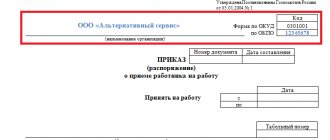During the period of work at the enterprise, its employees can be transferred from one position to another. This can happen for completely different reasons: promotion and demotion, the vacancy of a vacancy, the employee acquiring a new specialty, for medical reasons, etc. Regardless of what circumstances served as the reason for such a rearrangement, this action must be formalized properly. One of the main documents that accompany the transfer of an employee from one position to another within the organization is the manager’s order to transfer to another job in the T-5 form:
- Form and sample
- Free download
- Online viewing
- Expert tested
FILES
An important clarification: if any changes occur in the name of an employee’s position in the process of carrying out his activities, but the essence of the job functions performed remains the same, there is no need to draw up a transfer order.
What is the basis for the order?
Orders issued by company management must always have a basis. In this case, it may be a statement written on behalf of the employee himself (with justification for this desire) or a memorandum from the head of the structural unit, which must indicate compelling arguments for carrying out this procedure. If the transfer occurs at the initiative of the employer, then the employee must first be notified of the upcoming changes in his career.
Types of transfers
The movement of employees from one position to another may be of the following nature:
- Transfers to permanent or temporary work.
- Movements performed on the initiative of a subordinate or on the initiative of a manager.
- Transfer with the consent of the subordinate or without his approval.
There are also such types of translation as internal and external. The first type ensures the movement of a subordinate within one institution, the second - between different companies.
( Video : “Three meanings of translation”)
Constant
With the constant movement of a subordinate, the following can be carried out:
- Complete change of institution.
- Change of place of work together with the manager.
- Change of position under the same boss.
A subordinate can change his position on his own initiative by sending a request to the head of the company. At the same time, the manager has the right to refuse such a request, and if the outcome is positive, an additional agreement is drawn up, securing a new vacancy, showing wages, work schedule and other conditions that need to be reflected in the contract.
In addition to the concluded additional contract, an order is issued to move the employee to a new vacancy. The basis for issuing an order is the concluded additional agreement, which is reflected in the order. Also, information about a change in vacancy is entered into the work record book and into the employee’s personal card, which is maintained in the personnel department.
If the initiator of a permanent transfer is the management of the company, the manager is obliged to send a notification to the employee, displaying information about the new vacancy or workplace. If the employee agrees, an additional agreement is also concluded. If the employee refuses the offer, he may be expelled with the issuance of severance pay. Deduction is subject to the condition that there is no alternative vacancy.
If an employee has expressed a desire to move to work in another institution, the approval of the manager where the person works is required to fulfill the intention. If there is no such approval, then the subordinate can resign and, after working out, register for a new enterprise.
Temporary
Temporary transfer of a subordinate means a transfer to another place of work for a period of no more than one year. A transfer of this nature is confirmed by a written agreement of the transferred person.
If the period of temporary transfer ends, and the director or the transferred person does not remind him to return to his previous place of work, then such a transfer becomes permanent, and the old contract becomes invalid.
There may be circumstances where a subordinate can be temporarily transferred without his approval. This can be done in the following situations:
- In case of man-made or natural emergencies. Under these circumstances, the repaired person may be sent to another job for a period of no more than 30 days.
- When the operation of an institution is suspended.
Despite the fact that in exceptional situations the approval of a subordinate for transfer is not required, when he is sent to a lower vacancy, his written agreement is required. At the same time, remuneration cannot be less than the salary or average salary of the previous job.
Basic rules for placing an order
Today, the law says that an order to transfer an employee from one position to another can be issued in a free form. However, many enterprises and organizations, in the old fashioned way, prefer to use the previously approved and widespread T-5 form. This is understandable: the form contains all the necessary data, including information about the employer and subordinate, information about the former and new place of work, reasons for the transfer, etc.
The order can be filled out either by hand or on a computer, but it is printed out in a single copy and, after writing, is given first to the manager for signature, and then for review to the employee for whom it was drawn up. His autograph on the document will indicate that he agrees with the transfer to a certain position with the designation of a specific tariff rate and other conditions.
After registration, the order must be registered in the internal document register, and then transferred for storage to the personnel department.
What is the basis for the order?
In an order to transfer a subject to another job, the reason must always be noted. In accordance with the provisions of labor legislation, reasons for transfer include :
natural disaster (mass fires, tornadoes, floods);
- industrial accident. This implies both the elimination of the accident itself and its consequences, which is why additional personnel are needed. Also, such reasons include emergency situations where there are casualties;
- man-made disaster in the city;
- pandemics, as well as other conditions that pose a threat to a large number of residents of the locality.
- the presence of documented grounds that the employee can perform more complex and highly qualified work (for example, when taking training courses or receiving additional education);
- another position that suits a particular employee’s characteristics and in which he wants to work has become vacant, and the manager does not object to the transfer;
- a change of position is the only possible option for maintaining the subject as a full-time employee (in case of staff reduction or liquidation of the enterprise).
When transferring to another job, it is important to take into account that the employee’s consent is a prerequisite for the implementation of new responsibilities for the person. If there is an agreement between the parties to the agreement, the transfer is made taking into account one of the following reasons :
The transfer is also relevant if at a certain time an employee does not come to work for unknown reasons. That is, a specific employee, by order of the boss, can replace an absent person for one or more work shifts.
An example of filling out an order to transfer an employee to another job using the T-5 form
The standard sample in the T-5 form is quite simple and should not cause any difficulties during registration.
The first part of the T-5 form
The first part of the document indicates the full name of the organization, the OKPO code (in accordance with the registration papers), as well as its internal document flow number and the date of its preparation. Below is the period during which the employee will work in another position.
- If the transfer is temporary, then the start date and end date of the work (if the latter is known) should be indicated.
- If the transfer is made on an ongoing basis, then you only need to set the date from which the employee will be obliged to begin his new duties.
In addition, with a permanent transfer, information about it must be entered into the work book and the employee’s personal file, as well as an additional agreement to the employment contract must be drawn up with him (on changes in working conditions and other parameters).
Next, you should enter the employee’s last name, first name, patronymic, his personnel number (if such records are kept at the enterprise), and also indicate the type of transfer.
The second part of the T-5 form
In the second part of the document, information about the employee’s previous place of work is first entered, namely the structural unit where he worked and his position (in accordance with the staffing table). In the next line you need to indicate the reason for the transfer.
The second table contains information about the new location:
- department name,
- job title,
- as well as the size of the tariff rate and all possible allowances due to the employee.
Next, you need to provide a link to the documents that served as the basis for issuing the order: usually this is either a statement from the employee or a memo from his immediate superior. If the transfer is caused by some other factors (for example, an employee’s illness), then data from the supporting document (for example, a medical report) must be entered here.
Finally, the order should be given to the employee for review. Without his signature, the document will have no legal significance.
What it is?
A transfer order is a document notifying the transformation of the job responsibilities of an employee or a structural element of an enterprise, temporarily or permanently.
When drawing up the order, the employer notifies in writing of the change in his job duties. This may be in the form of a notice.
Sometimes this is accompanied by additional training, advanced training, or, conversely, a transition to a lower position.
From a legal point of view, all issues of moving up the official ladder must be legally drafted correctly .
Otherwise, the employee can challenge his transfer to another place in court , and win the case, while recovering not only material, but also moral damage.
To facilitate the preparation procedure, a unified form of some documents related to the transition of people was developed.
For example, if we are talking about the transfer of only one specialist, then you can use a form in the T 5 form.
In the case of several employees, the appropriate form would be form T 5a.
When you can’t and when you can refuse a transfer
There are situations in which the employer does not have the right to refuse to transfer an employee to another position: this is the employee’s pregnancy and the presence of young children, the presence of medical indications, etc. But, for example, a transfer due to staff reduction or to another location at the initiative of the organization is possible only with the personal written consent of the employee.
The employee himself can, at any time and for any reason, refuse a transfer initiated by the employer, and also demand that he be provided with another, more suitable position, with working conditions that suit him.
Drawing up an order in free form
- The full name of the legal entity is indicated in the header of the document.
- Next, write down the name of the document, the date of preparation and the assigned number.
Now we need to describe in detail the essence of the order. To do this, provide the following information:
- FULL NAME. and the position of the employee who will be transferred;
- name of the new position;
- the date from which the transfer will be made;
- salary for the new position;
- basis for transfer.
At the bottom of the order to transfer the employee to another job, his full name is indicated. and the signature of the general director. After this there should be the phrase “I have read the order,” the employee’s signature and the date of his familiarization with the order.
Based on the approved order, the HR department employee makes entries in the personal card and work book, and an additional agreement to the employment contract is concluded. If the transfer to another position is temporary, no entries need to be made in the work book.
Sample order in free form
Temporary transfer to another job without the employee’s consent
The Labor Code of the Russian Federation provides a list of factors and conditions under which an employee can be transferred without his consent:
- in the event of natural and man-made disasters, as well as other factors that pose a risk to the life and health of surrounding people;
- in case of downtime, as well as to eliminate the risk of damage and loss of property, if these circumstances were caused by the factors given above.
Such a transfer can be carried out for a period not exceeding 1 month.











